Association Between a Single General Anesthesia Exposure Before Age 36 Months and Neurocognitive Outcomes in Later Childhood
- PMID: 27272582
- PMCID: PMC5316422
- DOI: 10.1001/jama.2016.6967
Association Between a Single General Anesthesia Exposure Before Age 36 Months and Neurocognitive Outcomes in Later Childhood
Abstract
Importance: Exposure of young animals to commonly used anesthetics causes neurotoxicity including impaired neurocognitive function and abnormal behavior. The potential neurocognitive and behavioral effects of anesthesia exposure in young children are thus important to understand.
Objective: To examine if a single anesthesia exposure in otherwise healthy young children was associated with impaired neurocognitive development and abnormal behavior in later childhood.
Design, setting, and participants: Sibling-matched cohort study conducted between May 2009 and April 2015 at 4 university-based US pediatric tertiary care hospitals. The study cohort included sibling pairs within 36 months in age and currently 8 to 15 years old. The exposed siblings were healthy at surgery/anesthesia. Neurocognitive and behavior outcomes were prospectively assessed with retrospectively documented anesthesia exposure data.
Exposures: A single exposure to general anesthesia during inguinal hernia surgery in the exposed sibling and no anesthesia exposure in the unexposed sibling, before age 36 months.
Main outcomes and measures: The primary outcome was global cognitive function (IQ). Secondary outcomes included domain-specific neurocognitive functions and behavior. A detailed neuropsychological battery assessed IQ and domain-specific neurocognitive functions. Parents completed validated, standardized reports of behavior.
Results: Among the 105 sibling pairs, the exposed siblings (mean age, 17.3 months at surgery/anesthesia; 9.5% female) and the unexposed siblings (44% female) had IQ testing at mean ages of 10.6 and 10.9 years, respectively. All exposed children received inhaled anesthetic agents, and anesthesia duration ranged from 20 to 240 minutes, with a median duration of 80 minutes. Mean IQ scores between exposed siblings (scores: full scale = 111; performance = 108; verbal = 111) and unexposed siblings (scores: full scale = 111; performance = 107; verbal = 111) were not statistically significantly different. Differences in mean IQ scores between sibling pairs were: full scale = -0.2 (95% CI, -2.6 to 2.9); performance = 0.5 (95% CI, -2.7 to 3.7); and verbal = -0.5 (95% CI, -3.2 to 2.2). No statistically significant differences in mean scores were found between sibling pairs in memory/learning, motor/processing speed, visuospatial function, attention, executive function, language, or behavior.
Conclusions and relevance: Among healthy children with a single anesthesia exposure before age 36 months, compared with healthy siblings with no anesthesia exposure, there were no statistically significant differences in IQ scores in later childhood. Further study of repeated exposure, prolonged exposure, and vulnerable subgroups is needed.
Conflict of interest statement
Figures
Comment in
-
Is a short anesthetic exposure in children safe? Time will tell: a focused commentary of the GAS and PANDA trials.Ann Transl Med. 2016 Oct;4(20):408. doi: 10.21037/atm.2016.10.43. Ann Transl Med. 2016. PMID: 27867960 Free PMC article.
References
-
- Rabbitts JA, Groenewald CB, Moriarty JP, Flick R. Epidemiology of ambulatory anesthesia for children in the United States: 2006 and 1996. Anesth Analg. 2010;111(4):1011–1015. - PubMed
-
- Tzong KY, Han S, Roh A, Ing C. Epidemiology of pediatric surgical admissions in US children: data from the HCUP kids inpatient database. J Neurosurg Anesthesiol. 2012;24(4):391–395. - PubMed
-
- DeFrances CJ, Cullen KA, Kozak LJ. National Hospital Discharge Survey: 2005 annual summary with detailed diagnosis and procedure data. Vital Health Stat 13. 2007;13(165):1–209. - PubMed
Publication types
MeSH terms
Grants and funding
LinkOut - more resources
Full Text Sources
Other Literature Sources
Medical
Miscellaneous


